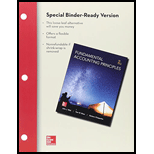
Concept explainers
Concept Introduction:
Inventory: These are goods which are owned by company and expected to sell in its normal course of business
Merchandise: The goods are referred as merchandise which the company purchases and resells the same goods to customers
Merchandiser: The Company who business is to buy the merchandise at purchases cost and sell the same merchandise at higher price which is sales price and earns profit. Merchandiser can be categorized as wholesaler and retailer
Perpetual Inventory System: Each merchandise purchase and sales cost are recorded and updated continuously for all merchandise. In perpetual Inventory system if merchandise is sold. The company determines the cost of goods sold and passes an accounting entry. It will debit “Cost of goods sold” and credit “Merchandise Inventory” . If merchandise is purchased it will pass the accounting entry by debiting “Merchandise Inventory” and crediting “Account payable” if purchases on credit or “Cash or Bank “if paid Cash or Cheque for the purchases
Sales under perpetual Inventory System: when merchandiser sells the goods it can be through cash sale or credit Sale. There will be two entries for each sales transaction as explained below
- When sale of merchandise is made as per revenue recognition principle. The revenue will be recognized by debiting “Accounts receivable” if there is credit sales or “Cash” if it cash sales and by crediting “Sales”
- The amount of cost of inventory which is sold the accounting entry will debiting “ cost of goods sold” and crediting “Merchandise Inventory”
Sales Return and allowance under Perpetual Inventory system: when the merchandise is returned by purchaser to the seller it is called Sales return . There will be two entries for each sales return transaction
- The quantity of merchandise returned by purchaser. the seller will record the accounting entry by debiting with “Sales return and allowance “ and crediting “Accounts receivable” if there is credit sales or “Cash” if cash is paid to purchaser
- As the merchandise has physically arrived at seller location and his physical inventory has increased. the accounting entry will be by Debiting “ Merchandise inventory “ and crediting “Cost of goods sold”
1. To Prepare:
Want to see the full answer?
Check out a sample textbook solution
Chapter 5 Solutions
Loose Leaf for Fundamentals of Accounting Principles and Connect Access Card
- Question: 22 - Hader company has actual sales of $82,000 in April and $63,000 in May. It expects sales of $78,000 in June and $92,000 in July and in August. Assuming that sales are the only source of cash inflows and that half of them are for cash and the remainder are collected evenly over the following 2 months, what are the firm's expected cash receipts for June, July, and August?need answerarrow_forwardA piece of equipment is purchased for $34,750 and has a salvage value of $4,350. The estimated life is 8 years and the method of depreciation is straight-line. Shipping costs total $950 and installation costs are $820. The book value at the end of year 8 is_. a. $3,110 b. $3,200 c. $2,000 d. $4,350 MCQarrow_forwardMCQarrow_forward

 AccountingAccountingISBN:9781337272094Author:WARREN, Carl S., Reeve, James M., Duchac, Jonathan E.Publisher:Cengage Learning,
AccountingAccountingISBN:9781337272094Author:WARREN, Carl S., Reeve, James M., Duchac, Jonathan E.Publisher:Cengage Learning, Accounting Information SystemsAccountingISBN:9781337619202Author:Hall, James A.Publisher:Cengage Learning,
Accounting Information SystemsAccountingISBN:9781337619202Author:Hall, James A.Publisher:Cengage Learning, Horngren's Cost Accounting: A Managerial Emphasis...AccountingISBN:9780134475585Author:Srikant M. Datar, Madhav V. RajanPublisher:PEARSON
Horngren's Cost Accounting: A Managerial Emphasis...AccountingISBN:9780134475585Author:Srikant M. Datar, Madhav V. RajanPublisher:PEARSON Intermediate AccountingAccountingISBN:9781259722660Author:J. David Spiceland, Mark W. Nelson, Wayne M ThomasPublisher:McGraw-Hill Education
Intermediate AccountingAccountingISBN:9781259722660Author:J. David Spiceland, Mark W. Nelson, Wayne M ThomasPublisher:McGraw-Hill Education Financial and Managerial AccountingAccountingISBN:9781259726705Author:John J Wild, Ken W. Shaw, Barbara Chiappetta Fundamental Accounting PrinciplesPublisher:McGraw-Hill Education
Financial and Managerial AccountingAccountingISBN:9781259726705Author:John J Wild, Ken W. Shaw, Barbara Chiappetta Fundamental Accounting PrinciplesPublisher:McGraw-Hill Education





